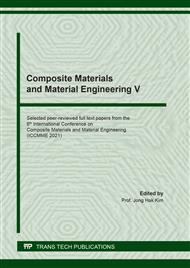p.3
p.9
p.15
p.21
p.27
p.32
p.38
p.44
p.53
Investigation of Mechanical Properties of Silk and Epoxy Composite Materials
Abstract:
This research Investigates the new composite materials are fabricated of two or more materials raised. The fibers material from the sources of natural recycled materials provides certain benefits above synthetic strengthening material given that very less cost, equivalent strength, less density, and the slightest discarded difficulties. In the current experiments, silk and fiber-reinforced epoxy composite material is fabricated and the mechanical properties for the composite materials are assessed. New composite materials samples with the dissimilar fiber weight ratio were made utilizing the compression Molding processes with the pressure of 150 pa at a temperature of 80 °C. All samples were exposed to the mechanical test like a tensile test, impact loading, flexural hardness, and microscopy. The performing results are the maximum stress is 33.4MPa, elastic modulus for the new composite material is 1380 MPa, and hardness value is 20.64 Hv for the material resistance to scratch, SEM analysis of the microstructure of new composite materials with different angles of layers that are more strength use in industrial applications.
Info:
Periodical:
Pages:
27-31
Citation:
Online since:
June 2021
Authors:
Price:
Сopyright:
© 2021 Trans Tech Publications Ltd. All Rights Reserved
Share:
Citation:


